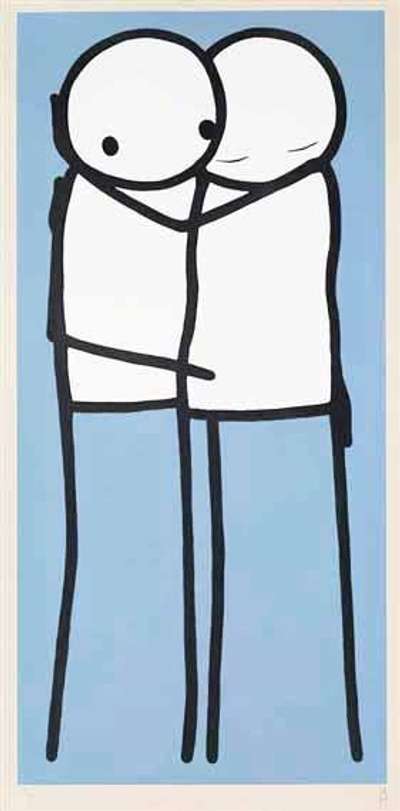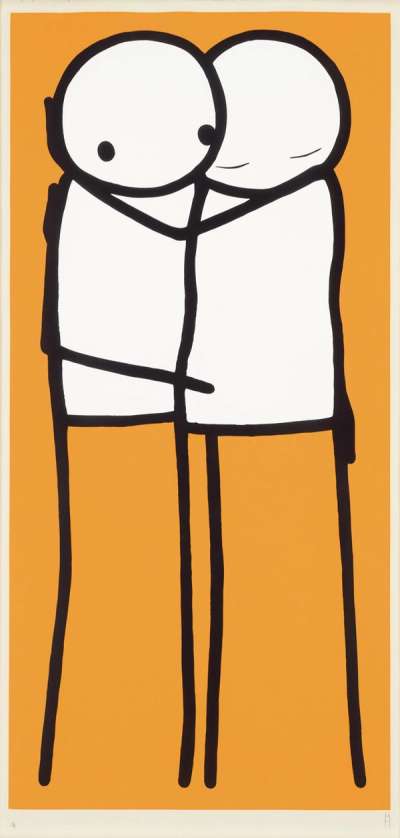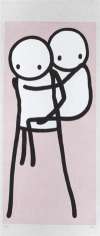Lovers
Despite its minimalism, Stik’s Lovers brims with a sense of love's security: two of Stik’s iconic stickmen figures embrace, facing inwards to each other. Their anonymity recalls Surrealist René Magritte’s The Lovers, but Stik takes this ambiguity further, deliberately giving obscuring his figures' genders to subvert typically heteronormative images of lovers.
Stik Lovers For sale
Lovers Value (5 Years)
Sales data across the Lovers series by Stik varies by print. While standout works have sold at auction for up to £50000, other editions in the series remain rare to market or have yet to appear publicly for sale. Of those tracked, average selling prices have ranged from £20100 to £25000, with an annual growth rate of 15.49% across available data. Collectors should note the discrepancy in performance between more visible and lesser-seen editions when considering value potential in this series.
Lovers Market value
Auction Results
| Artwork | Auction Date | Auction House | Return to Seller | Hammer Price | Buyer Paid |
|---|---|---|---|---|---|
 Lovers (orange) Stik Signed Print | 18 Sept 2019 | Christie's London | £22,100 | £26,000 | £35,000 |
 Lovers (blue) Stik Signed Print | 12 Sept 2019 | Phillips London | £16,150 | £19,000 | £25,000 |
Sell Your Art
with Us
with Us
Join Our Network of Collectors. Buy, Sell and Track Demand
Meaning & Analysis
A pair of screenprints depicting Stik’s signature motif, the stick man, Lovers shows two figures locked in embrace, quite literally joined at the hip.
In Lovers, two stickmen embrace. While one has their eyes closed, indicated by two lines, the other has a startled gaze towards the former. The figure on the left wraps an arm under the chin of the second, while the second has one hand on the first’s body and the other wrapped around their lover’s waist. The figures are equal in height, literally joined at the hip, with the outline of one side of each of their bodies sharing a single line. The figures’ lack of clear gender identity is particularly potent here, subverting conventional images of lovers embracing. The anonymity of the image in Lovers recalls Magritte’s The Lovers, but the minimalist ambiguity of the figures in this series takes the lack of legible identity further.
Images of two figures in physical contact are not uncommon in STIK’s oeuvre. There is Holding Hands, perhaps STIK’s most recognised work, which drew couples of all kinds to pose alongside its statue in Hoxton Square. Then there is A Couple Hold Hands in the Street, voted the UK’s 17th favourite street art piece in a nationwide poll. But Lovers is perhaps Stik’s most intimate depiction of physical closeness between two of his iconic six-line figures. Departing from the overtly political themes of other key works, Lovers is a rare representation of romantic affection. The image originates in a mural painted by STIK in opposition to the local council’s clampdown on a squat in Dalston Lane. He stated of the community to which the mural was dedicated: 'The squat was a safe house for people from oppressive regimes, for queer and transgender people who were not safe in their home towns or home countries… There was no real service like it within the mainstream infrastructure – this was something that was lacking.'
In the image, the figures look inwards towards each other, rather than outwards, as is more conventional in the artist’s portfolio. As such, there is an emphasis on interpersonal closeness and warmth. While STIK’s figures tend to look out to the wider world, these stickmen appear to retreat from it, finding security in an embrace.













